Pork Sugo
Sugo, Ragù, or Bolognese all refer to the same thing-- a rich, meaty sauce simmered for hours and served on top of creamy egg noodles. It's the ultimate in Italian comfort food. Even though the start to finish time is long, the effort is minimal and the flavors are amazing. Make ahead to reheat for a next-day dinner party or serve right away for dinner. Read more about sugo and some other variations recipes here.
Heat the oven to 325.
Cut your bone-in pork shoulder or pork roast into 4-5 pieces, following the white lines of fat as a cutting guide. Remove any large chunks of fat and discard. Pat the pieces dry and season with salt and pepper.
Heat up your oil over high heat and brown for a few minutes on each side, until a nice golden brown crust develops. Remove to a side plate.
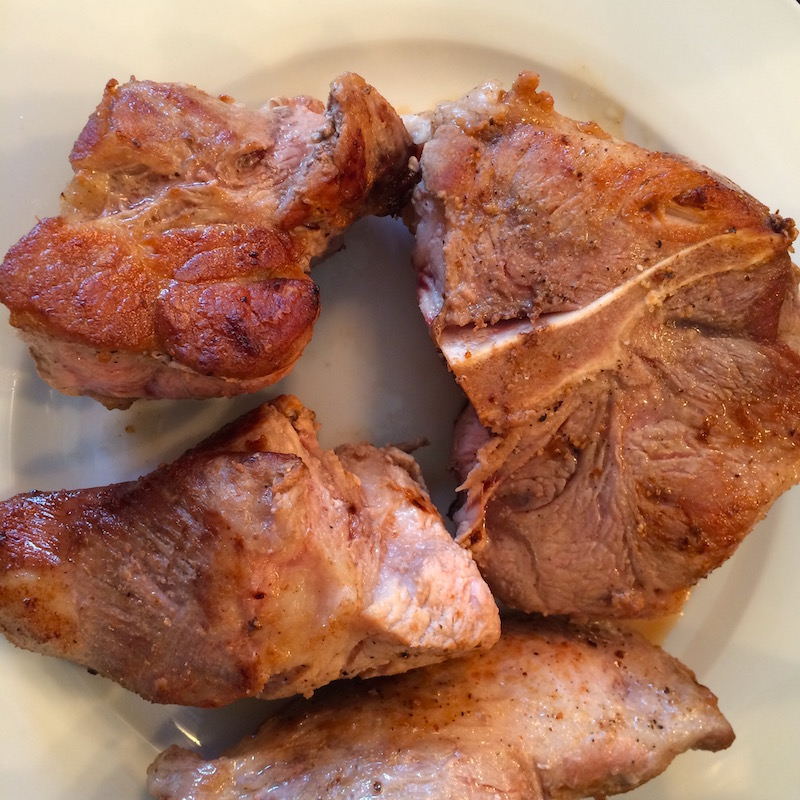
In the drippings, soften your finely diced onion, carrot & celery for 7-8 minute over medium heat, and then add in your tomato paste and cayenne or red pepper for an additional 2-3 minutes. Stir to coat, and then pour in the red wine and reduce by half (another 8-10 min.)
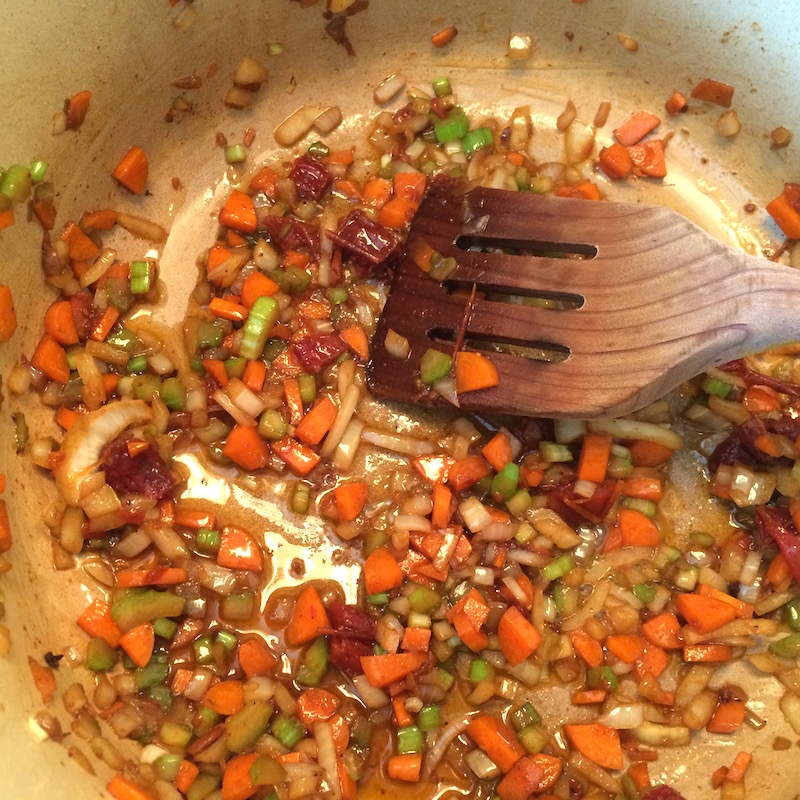
Meanwhile, heat up your chicken stock, your tomato sauce and your thawed, chopped tomatoes. The tomato sauce and tomatoes can be warmed in the same pot, but keep the stock separate.
Add the pieces of pork back into the veggies and pour the tomatoes and tomato sauce all around them. Ladle in about 1 cup of the chicken stock, and the spices (oregano, rosemary and bay leaf.) Cover and remove from heat.
Place the covered pot into the oven for 3 hours. Check once halfway to make sure the liquid isn't too low, and add more stock as needed.
After three hours, check to see if the pork is falling off the bones and whether a small sharp knife easily slides in. Two options now, depending on when you'd like to serve it:
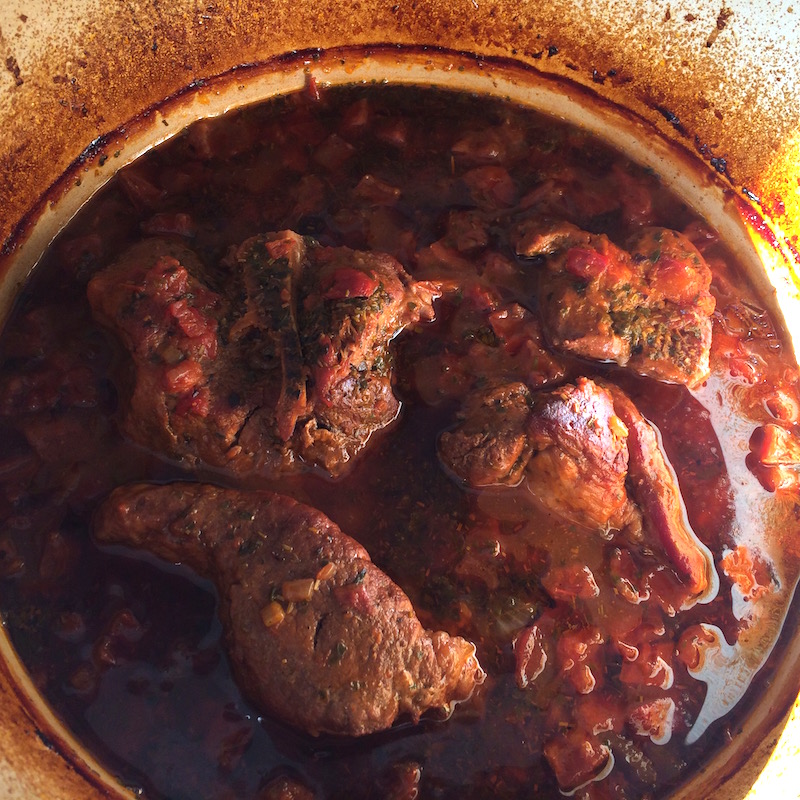
MAKE AHEAD: This dish tastes even better the second day. Once it's cooled, place the whole pot into the fridge overnight. About an hour and a half before serving the following day, bring it out and scoop off any congealed orange fat and discard. Heat it up so you can stir (maybe adding in more chicken stock, the sauce will get thicker in the fridge.)
CONTINUE RECIPE: If you are continuing to cook the dish and serve it right away, spoon off most of the thin, orange-colored fat that settles on top after a few minutes off heat.
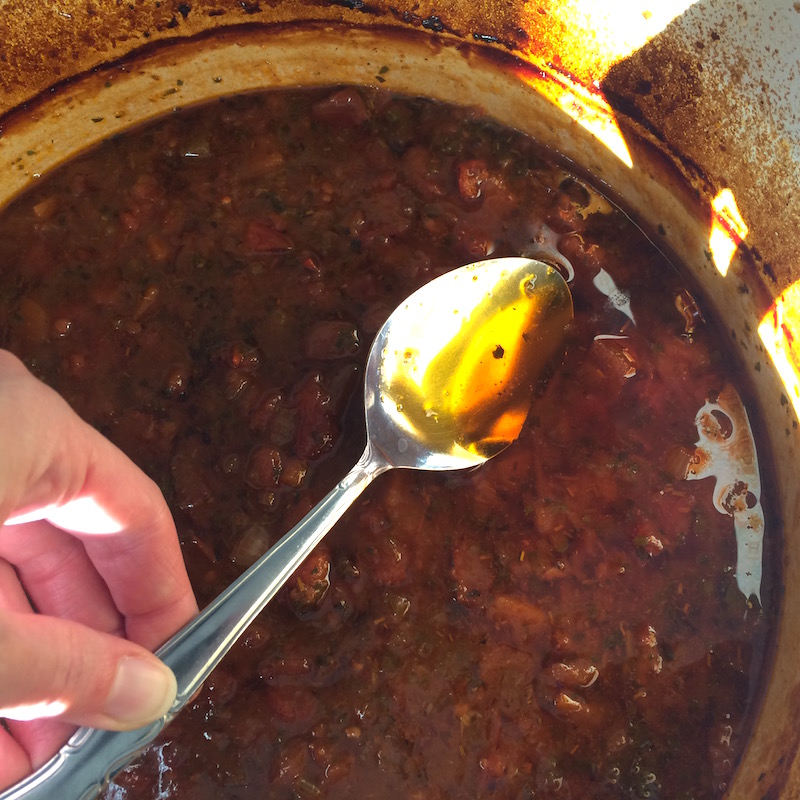
Make your pasta and reserve a little of the water. A pappardelle style or egg noodle is traditionally used, but just about any pasta you have will work.
Remove the meat from the sauce. Using your fingers, pull it off the bones and shred it, and discard bones. Remove the bay leaf and discard. Bring the sauce to a boil and reduce for about 10 minutes. Optional to pass the sauce through a food mill (if you don't have a food mill, you can just use a blender or skip.)
Add the shredded meat back to the sauce and reduce heat to medium-low. Place the cooked and strained pasta back in its cooking pot and add in some of the pork sugo and a splash (1/4-1/3 cup) of pasta water. Optional to add a little minced kale in too. Stir so the sauce clings to the noodles and absorbs some of the pasta water.
Serve in individual dishes, and top with more sauce. Pass some minced parsley and freshly grated parmesan for garnish.
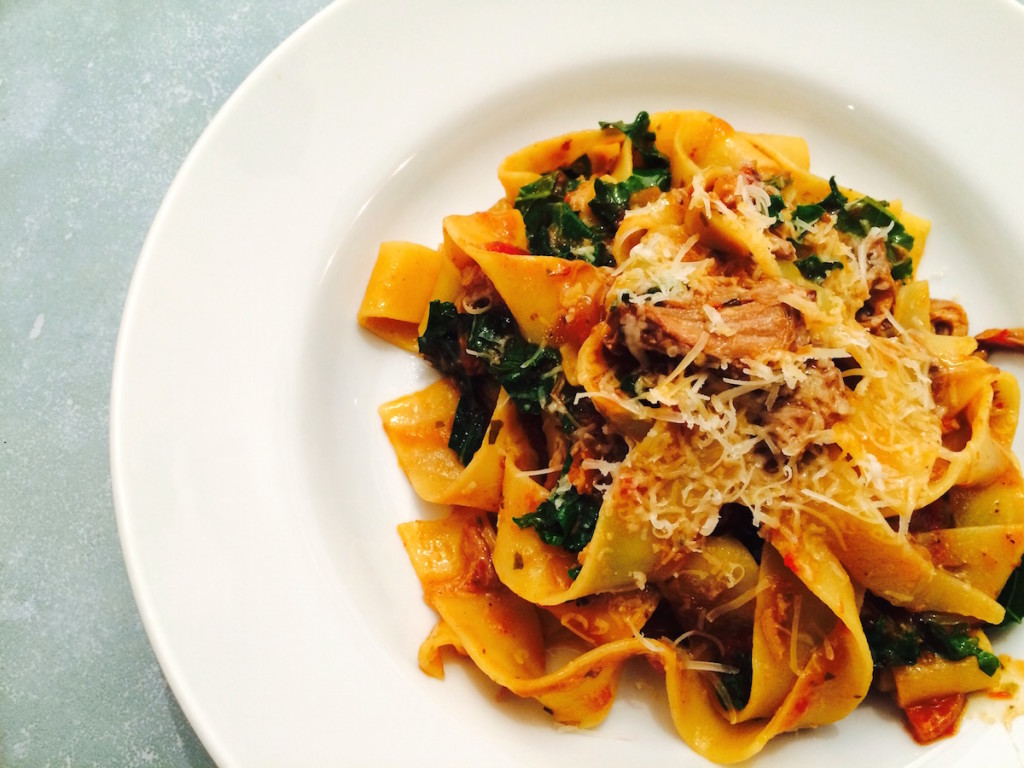
This sauce freezes really well (without pasta) for easy and delicious leftovers or lunches throughout the week. You might want to add a little water or stock when reheating.
Ingredients
Directions
Heat the oven to 325.
Cut your bone-in pork shoulder or pork roast into 4-5 pieces, following the white lines of fat as a cutting guide. Remove any large chunks of fat and discard. Pat the pieces dry and season with salt and pepper.
Heat up your oil over high heat and brown for a few minutes on each side, until a nice golden brown crust develops. Remove to a side plate.

In the drippings, soften your finely diced onion, carrot & celery for 7-8 minute over medium heat, and then add in your tomato paste and cayenne or red pepper for an additional 2-3 minutes. Stir to coat, and then pour in the red wine and reduce by half (another 8-10 min.)

Meanwhile, heat up your chicken stock, your tomato sauce and your thawed, chopped tomatoes. The tomato sauce and tomatoes can be warmed in the same pot, but keep the stock separate.
Add the pieces of pork back into the veggies and pour the tomatoes and tomato sauce all around them. Ladle in about 1 cup of the chicken stock, and the spices (oregano, rosemary and bay leaf.) Cover and remove from heat.
Place the covered pot into the oven for 3 hours. Check once halfway to make sure the liquid isn't too low, and add more stock as needed.
After three hours, check to see if the pork is falling off the bones and whether a small sharp knife easily slides in. Two options now, depending on when you'd like to serve it:

MAKE AHEAD: This dish tastes even better the second day. Once it's cooled, place the whole pot into the fridge overnight. About an hour and a half before serving the following day, bring it out and scoop off any congealed orange fat and discard. Heat it up so you can stir (maybe adding in more chicken stock, the sauce will get thicker in the fridge.)
CONTINUE RECIPE: If you are continuing to cook the dish and serve it right away, spoon off most of the thin, orange-colored fat that settles on top after a few minutes off heat.

Make your pasta and reserve a little of the water. A pappardelle style or egg noodle is traditionally used, but just about any pasta you have will work.
Remove the meat from the sauce. Using your fingers, pull it off the bones and shred it, and discard bones. Remove the bay leaf and discard. Bring the sauce to a boil and reduce for about 10 minutes. Optional to pass the sauce through a food mill (if you don't have a food mill, you can just use a blender or skip.)
Add the shredded meat back to the sauce and reduce heat to medium-low. Place the cooked and strained pasta back in its cooking pot and add in some of the pork sugo and a splash (1/4-1/3 cup) of pasta water. Optional to add a little minced kale in too. Stir so the sauce clings to the noodles and absorbs some of the pasta water.
Serve in individual dishes, and top with more sauce. Pass some minced parsley and freshly grated parmesan for garnish.

This sauce freezes really well (without pasta) for easy and delicious leftovers or lunches throughout the week. You might want to add a little water or stock when reheating.

I’ve made this recipe twice. It’s been terrific each time.